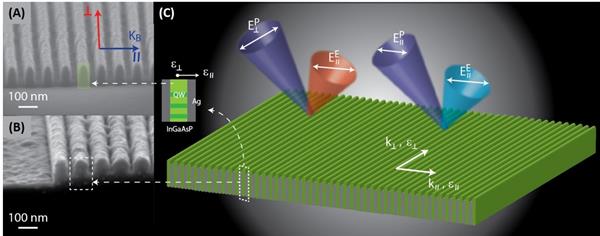Light-Emitting Hyperbolic Metasurfaces
Background
Hyperbolic metasurfaces (HMS) merge the exotic properties of hyperbolic metamaterials with the potential for lower losses and better device coupling offered by planar metasurfaces. Despite use of single-crystalline silver (Ag), HMS remain inherently lossy, limiting potential applications. Recent work has suggested that Ag could be combined with indium gallium arsenide phosphide (InGaAsP) multiple quantum wells (MQW) to enable transparent propagation of signals through waveguides and multilayers. Described here is the first experimental demonstration of a luminescent HMS (LuHMS) based on nanostructured (NS) Ag/InGaAsP MQW.
Technology Description
Researchers at UC San Diego have an invention, whereby the wavelength range in which the composite material exhibits hyperbolic dispersion, absorption and emission of radiation overlap, thereby earning the name LuHMS. The LuHMS works in conjunction with an external light source, heretofore called the "pump." Upon excitation by the pump, the LuHMS absorbs photons, creating electron-hole pairs. The amount of electron-hole pairs generated for a fixed pump intensity depends strongly on the polarization state of the normally incident pump beam, with maximum carriers generated for pump polarization parallel to the optical axis. Similarly, for fixed pump polarization, the amount of carriers generated increases with the intensity of the pump beam. The electron-hole pairs recombine to form photons of lesser energy than the pump photons, which are emitted from the LuHMS. The polarization of the collected photons is predominantly parallel to the optical axis, despite the fact that the polarization of collected photons from the bare InGaAsP MQW is more polarized in the orthogonal direction. When driven by an external optical pump at 1064nm, the HMS emit broadband radiation in the 1200nm-1600nm spectral range. Extreme anisotropy of total emission with respect to the pump polarization is observed, with peak PL differing by more than an order of magnitude for orthogonal pump polarization states. Additionally, we measure degree-of-linear-polarization of the emission as high as 0.9.
Compared to existing hyperbolic metamaterials (HMM), the LuHMS is the only HMM wherein the constituent dielectric is a light emitting material. Other HMMs have incorporated light emitting molecules or quantum dots in addition to their constituent metallic and dielectric components. The LuHMS consists of only 1 metallic and 1 dielectric component, the latter also being the light emitting component. Additionally, the optical (unique) axis of the LuHMS lies in the plane of the electric field vector of a normally incident pump beam. By contrast, the optical axis of all other HMMs that have incorporated light emitting molecules or quantum dots is parallel to the direction of propagation of a normally incident pump beam.
Applications
The invention can be used as an integrated polarization sensor, a polarized light emitting diode or as an absorption modulator.
Advantages
The unique architecture of the LuHMS enables extreme polarization anisotropy of a normally incident pump beam, which is not possible in other HMMs that incorporate light emitters.
State Of Development

Intellectual Property Info
Patent pending with device and circuit-level applications of the active HMS demonstrated.
Related Materials
- Smalley, J. S. T. et al. Luminescent hyperbolic metasurfaces. Nat. Commun. 8, 13793 doi: 10.1038/ncomms13793 (2017) - 01/09/2017
Patent Status
| Country | Type | Number | Dated | Case |
| United States Of America | Published Application | 20190031955 | 01/31/2019 | 2016-268 |
Contact
- University of California, San Diego Office of Innovation and Commercialization
- innovation@ucsd.edu
- tel: View Phone Number.
Other Information
Keywords
meta-surfaces, light emitting diodes, LED, polarization, modulator
